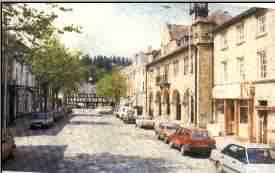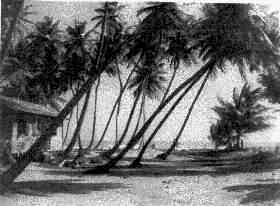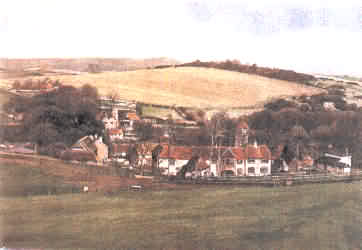
The composer in Wales, 1966
An unusual body of work on the part of Apivor is the
group of works centred round the paintings of Paul Klee,which is the
subject of an interesting review in the book on the subject by the
American writer, Steven Ellis. The first of these works, completed
in 1962 and performed in 1966 by the Philharmonia orchestra under
Brian Balkwill (BBC 3), deployed an extended chamber-orchestra of
solo players,at times divided into two sections. The essay in unusual
timbres embraced saxophone, guitar, mandolin and xylophone in addition
to more traditional classical instruments. In 1970, ApIvors Third
symphony, also of chamber music proportions was presented in Wales,
under John Carewe. In the same year the Reddiffe concerts commissioned
another Klee-based work for Chris Bowers-Broadbent, on the Festival
Hall Organ. Aplvor's choice of Klee works here was Orgelberg,
a mountain of organ pipes, reminiscent of the Festival Hall organ
façade. Later, during the 1970s, three other Klee-based musical
essays appeared. The first of these was the clarinet and piano work
based on psychological titles common in Klee's work, and called Psycho
Pieces - played first by Thea King and Susan Bradshaw, in a BBC-3
performance in 1976. Following this relatively modest canvas, Aplvor
chose the Klee work Resonance of the Southern Flora for one
of his most extensive canvases and, in addition to a large orchestra,the
score requires a small chorus and concert organ, though the work is
still largely written in a succession of transparent timbres.This
work remains unperformed. The Redcliffe concerts again stepped in
and performed the last of these Klee works, based on the extraordinary
line-up of humanoid characters in Klee's Exotics Theatre. The
chamber orchestra deployed 10 instruments and was both, at times diaphonously
impressionistic, and rhythmic, in the manner of the Stravinsky pieces
of the period after 1914. Many of these pieces of ApIvor's Klee involvement
visualised the possibility of an alternative 'total theatre' environment;
of back projection. Very much in this genre was the meticulously constructed
series of variations on the Trumps of the Tarot pack for 22 instruments
(used 11 at a time), TAROT.
Tarot is also one of a series of philosophic
or religious works, which include the Chorales by the mystical
poet, Hugo Manning, much inf luenced by the concepts of the Dao De
of Lao Tzu and Mahyana Buddhism; and the Dylan Thomas Cantata (op32)
based on the Altarwise by Owl light sonnets. From the uncompromising
Dylan Thomas work of 1961 to the later music dating from 1990 and
beyond, is a considerable step. At this point the composer completely
rejected serialism and what one might call the complexities of abstraction,
and linguistic experiment, urged on by a total volte-face in religious
and philisophic view point, away from the 'modern movement', which
after half a century has lost its original impetus and degenerated
into posturing of an avant-garde nature, capable of only a sort of
'second-hand reproduction' of valid and one-time effective attitudes.
The discovery of the simplicity and serenity of some oriental models
in terms of a real interior content based on faith and melodic genuineness,
has been paralleled here in the west by the moving extrapolation of
music backward, through earlier centuries, revealing a mine of beautiful
melodic sound, and choral ingenuity, The renaissence and baroque sound
in the works for voice, for organ and for the real instruments of
revivified construction, has struck a mortal blow
at the feeling, not so many years old that there was no future for
contemporary musical art, except through linguistic experiment, serialism,
minimalistic posturings, and other "music about music". Musings of
this sort and many others, afflicted the composer during the 1980s,
and made it difficult to use his previous methods with conviction.
During the 1990s he began composing small works with
a deliberate intention to restict the material to a few tones in each
piece, and avoiding harmonic complexity or aggresive modulation ,
to concentrate on a continuous melodic approach, and significant and
clear emotional content. Such works commenced with the Third String
Quartet (op 84) The most extended of these works is the Fifth
Symphony of which the slow movement is an elegaic commentary on
the Death of the Buddha, which has something in common with Satie's
Socrate, a non-demonstrative, but moving, meditation on the
Death of Socrates .
|

LLANIDLOES
|
In 1987, Denis Aplvor left his London address
in South Hill Park on the Hampstead Pools for a small house
on a Welsh hillside, which had been a Forest Lodge (Hafren Lodge)
not far from Llanidloes and on the way to the somewhat desolate
Clwyedog Dam
|
In the immediate years after the war, and until his
exit to Trinidad to compose the opera Yerma, the composer had
rented a flat in the attractive Georgian row, Regents Park Terrace.
By a curious concatenation of circumstances this location was within
a stones-throw of the London headquarters of his friend Dylan Thomas
in Delancey St, and Constant Lambert's house at the top of Albany
St, next to the Danish church, and sometimes described by the composer
himself as 'in a monastery garden' . Not far away, on the edge of
the Park was Bill MacAlpine, Joycean scholar and close friend of Thomas.
Alan Rawsthorne was, in theory, resident in nearby Ormonde Terrace
in his moments of return to his wife Jessie Rawsthorne, the violinist.
Louis MacNeice the poet, and Rawsthorne's friend, lived a few hundred
yards away in a house on the edge of the park. After Constant's death
in 1951 and the tragic removal of Dylan Thomas from the scene, Isabel,
the painter, Lambert's widow and Rawsthorne's wife-to-be lived for
a while in Dylan's old haunt in Delancey St.
The result of this relative closeness in the normally
sprawling ambience of London relationships, was to produce a deceptive
sense of closeness in a small group of people, such as was never resumed
in later years. Parties were held at the various locations; and one
was as likely to meet with Constant hurrying down Parkway to the wine-bar
at Camden Town, as Thomas with Cattie and others on his way from Delancey
St to the York and Albany, opposite the park .
At a party at Regents Park Terrace before 1951, Constant
appeared and was rewarded by special attention from the white cat,
who draped herself around his shoulders, as a prelude to a two-piano
extempore performance by Aplvor and Lambert of dances from Offenbachs
Orpheus, at 2 am. Cats were grouped by Lambert into two categories
- "shoulder-cats" and "Full-Score" cats, according to their favourite
locations.
On the night of Constant's funeral an extraordinary
wake was held for four persons - Alan and Jessie and Aplvor and Elisabeth
Lutyens. Lutyens appeared at many of the parties, and even at times
broke them up by shouting.

A more welcome guest and wonderful companion in friendship and erudition
was Edward Clark; but the couple were busy breaking up their marriage
and in the impending centripetal movement, she departed for a prestigious
location in Blackheath, while he as good as starved in the old environs
of the Fitzroy St office. Aplvor's success in ballet, and the Yerma
commission led him to the West Indies. After his return and a
sojourn,orchestrating the opera, he ended up spending a part ot every
week with the ballet critic, Fernau Hall, who had admired his theatre
work in the early 1950s; and rented the flat above him in South Hill
Park at no 44, which had a longish garden extending down to the Pond.
After Aplvor's divorce and marriage to Rima Austin, they
bought a section of the house, in company with Fernau Hall and occupied
it until the late 1980s, when relations with the ballet critic deteriorated;
a process which was speeded up considerably by Hall's degeneration
of health into a curious state known as "Munchausen's syndrome" which
took him, in a slightly bogus way, into a series of London hospitals,
from which he was ejected, sometimes at speed. The lack of sympathy
elicited from the medical side of the composers make-up acted as a
fairly deadly blow to futher relations. Aplvor and his wife, Rima,
a skilled choreologist, and member of the Institute set
up by the Benesh pioneers, had by this time two children, one of them,
the musician and painter Dylan, studying at Chelsea Art School. Their
exodus to the closeness of his father's old Merioneth stamping grounds,
and the hills where Peter Warlock had roved in writing some of his
most songs, had its fascinating and moving aspect. But the composer's
frame of mind was complicated by serious agonising over how to continue
his work in the aftermath of his disillusionment with serialism and
the 'avant-garde' ethos, which had sustained him for some thirty years.

Telscome Village
To complicate matters, he was the victim of a serious
loss of sight of his left eye in 1988, and a subsequent fall which
partially crippled him until 1990. The couple left Wales with a good
deal of regret and settled at Telscome on the South channel coast,
near Brighton, where their son was doing a university course in art
and music. Their daughter Lyndel, who was fully bilingual in English
and Spanish, was teaching English and doing university studies in
the Canarias. Once he established a clear direction in which to move,
Aplvor produced a whole series of works of small dimensions and in
simplified style. The saxophone works originated from his son's interest
in the instrument for a period, in 1990; and included the Lao Tzu
pieces, called Pieces of Five for the solo instrument;
and a Sonatina on a short theme for the mediaeval poem,Quia
amore langueo, conceived some forty years ago,and never used in
conjunction with the mystical poem in question .
The same source gave rise to the Viola and Piano Sonatina
called Fair love let us gan play (op 90 1992) . Aplvor's friendship
with the South African organist and musical writer, Barry
Smith took place at this time, in connection with Professor Smith's
new enterprise, in writing a biography of Peter Warlock,
for the centenary year of the composers birth, in 1994.
Aplvor corresponded with enthusiasm with the Capetown
conductor and writer on all aspects of the Warlock saga, now to be
revealed in much detail, since the neccessary caution of the poetic
Cecil Gray memoir,of 1934. For Barry Smith, Aplvor ( also composed
his first large-scale organ work, since the solitary, serial essay
for Bowers-Broadbent in 1972. The Capetown pieces were in the shape
of three books, entitled Organisation of Preludes and Postludes,and
influenced much more by the Spanish, renaissence organ-school than
by any of the modern masters of large-scale, complex sound, like Messiaen.
Barry Smith, in his turn, requested a work to accompany
his presentation of Warlock's The Curlew in a celebratory concert,
in Capetown during 1994 . The result was the septet, entitled In
the Landscape of Spring, which owed its title to a Ch'an (Zen)
saying, by one of the great Masters of the T'ang dynasty .
Most of the succeeding pieces of this period were
vocal. Perhaps the situation on the Sussex downs was responsible for
the taking up of a project lying dormant for a decade, to set to music
a group of the sonnets by the Sussex poet, Hilaire Belloc, for solo
voices, unaccompanied. Aplvor had admired for years two of the Warlock
Belloc settings; The Night and Hanacker Mill. Since
his appearance in Sussex the announcement was made that the Mill was
to be restored; which caused Warlock's heart-rending setting of the
sad poem on the downfall of the English countryside and the disappearance
of the kindly mill-girl, Sally. Of more interest, perhaps, in the
light of the composers past involvment with the work of T.S Eliot,
are a groups of songs employing some of the words of the so-called
"minor poems". Of these, the poem Eyes that last I saw in tears,
was the most interesting, as providing an astonishing parallel with
the section Eyes that last I saw in dreams, set to music in
his expressionistic style, of the perio - as part of the Hollow
Men work of 1939. This later version was very similar in its imagery;
but quite different in its suggestion of 17th-century formality; and
in that matter suited precisely the changed mood and method of Apivor's
style of the '90s. With it went the extraordinarily menacing wind
sprang up at four o'clock, with indeterminate echoes
of a section of the Waste Land. The other poems were three of the
innocuous, but doom- laden lyrics from Five Finger Exercises,
first performed at an Alan Rawsthorne Society concert with a special
recorder-oblicato, by John Turner, in 1992, At the same time Aplvor
was closely involved emotionally with Eliot's remarkable Lady
of Silences section of the (1930) Ash Wednesday , which
seemd to the composer to give an extraordinary clue to Eliot's grief
and psychological dilemma of the period, which had nearly destroyed
him. This clue led, in the Lady of Silences lyric, through
an obsessive neutralisation of an agonised burden of "dualism", as
though the poet has recognised the phenomenon, but was only just seeing
his way through the 'mystery', to reality lying hidden
behind it. This work was once again set for a small group of choral
singer, but accompanied by strings, harp, and the composer's old favourite
percussion instrument, the "piano harp"; the etherial sound
of the strings played by fingers and beaters, with the mechanism of
hammers removed.
To summarise this short biographical sketch. Denis
Aplvor's work has extended through the mid-century from 1935 until
the 90s, and has come under the influence of the major figures like
Stravinsky, in some of the ballets and in his instrumental sounds
and methods in such works as Crystals, and the large scale
Tamar and Amnon for soloists chorus and orchestra. Superimposed
on a special interest in song and vocal work derived from his early
days as a cathedral chorister was the potent oeuvre of Warlock's song
writing, with its combination of primitivism in religious models and
the modern harmonic twist derived from his associates like van Dieren
and Delius. This influence never left him and persisted side by side
by a strong involvement, in London, with the twelve-tone ethos, led
at the time by Edward Clark, a close friend and his constant exposure
of the work of his own German masters and associates Schönberg,
Alban Berg and Webern. The late impact of Webern in the 1960s here
in England had a profound impact on Aplvor's work from the time he
met the Webern recordings in about 196O; and his instrumental works
and the three operas that appeared from 1959 until 1974 showed the
strong influences of that school, as did most of the early piano pieces
and guitar works from 1959 onwards. Many of the solo vocal works of
the period however retained a more traditional loyalty to the romantic,
and tonal principles learned from Heseltine, as a young man; and this
explains the occurence in the midst of a serial instrumental obsession
of works like the Lorca and Beddoes song-cycles, and the later groups
Vox Populi and the Dowson group, Loves Season,
both 14 songs in length. Larger choral work of the period, such as
the Dylan Thomas Cantata (op 32), however were among the composer's
most uncompromisingly difficult, serially-composed ,choral work; and
for that reason have failed to obtain any sort of adequate public
hearings.
Aplvor's ballet work made a considerable impact in
the 1950s; but his attempt to transfer to the more complex operatic
field, though at first it was through commission by a national institution,
was blocked by unknown forces, and has to remain something to be discovered
by future sponsorship. ApIvor is a composer whose close interest in
verse and the visual arts has led him to work in some ways like a
painter, being involved from time to time in groups of works ,centred
on certain artists and deriving a style specially adapted to deal
with that perioli and subject. This applies very much to his Klee-based
works; to the T.S. Eliot cycle of pieces, through The Hollow Men,
the Landscapes and the later vocal works; the song group and Lady
of Silences; and the considerable volume of Lorca-based works
in opera),ballet, and smaller pieces for voice and for guitar.

The composer's studio
The relatively poor exposure of most of his works
in his own country has made an estimation of the impact impossible
of the work as a whole; but suffice it to say that the composer has
covered most fields, some in a considerable degree, which would make
him more worthy than many of his British contemporaries for
consideration as an all-round figure of significance. He has also
worked for the music of other comnposers: in literary terms for the
exposure of such figures as Christian Darnton, Peter Warlock, and
van Dieren; and in the case of the doubly-unfortunate van Dieren,
struck throughout life by fatal and crippling illness, his compassion,
derived from his other side as a medical man, has led him to devote
extensive periods of time in editing and arranging work, which seemed
otherwise doomed by circumstances to oblivion.
Postscript
Rima exhibited symptoms of Motor Neurone disease in
1991 and died in 1997.


 Return to:
Music on the Web
Return to:
Music on the Web